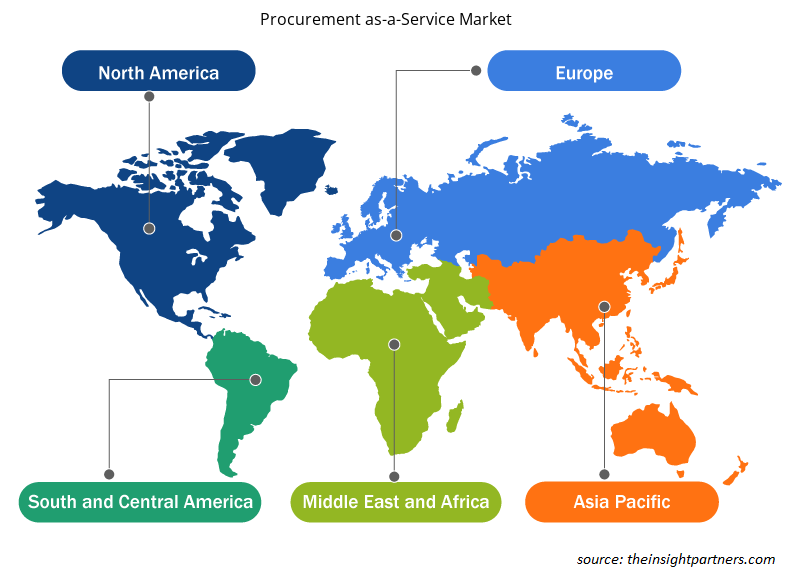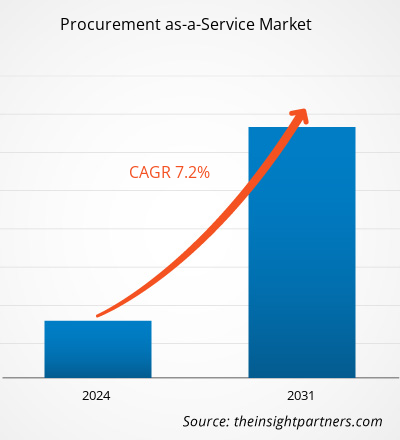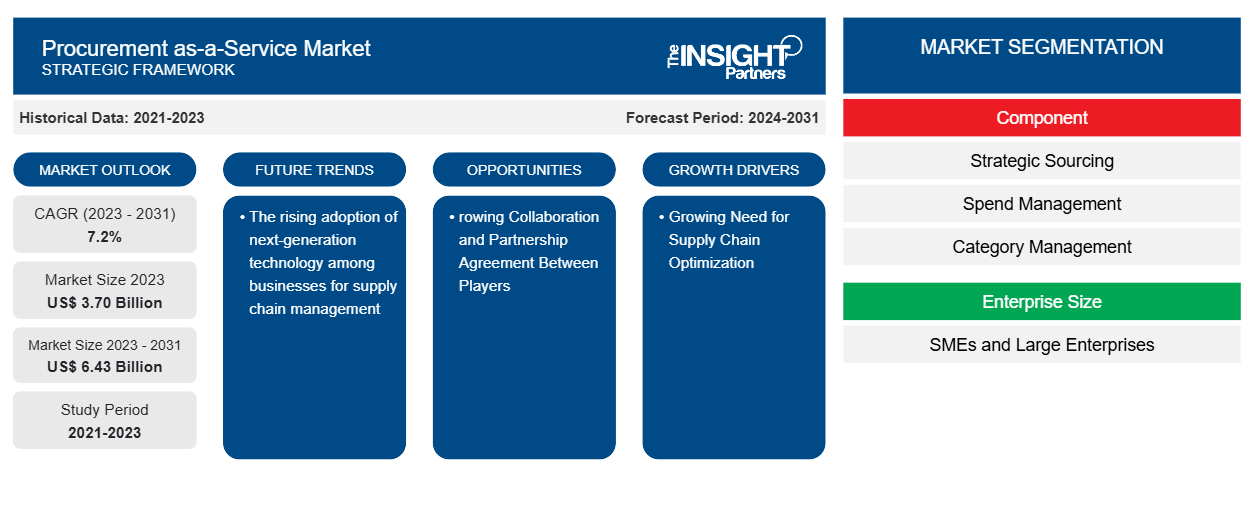Das Marktvolumen für Beschaffung als Dienstleistung wird voraussichtlich von 3,70 Milliarden US-Dollar im Jahr 2023 auf 6,43 Milliarden US-Dollar im Jahr 2031 anwachsen. Der Markt wird voraussichtlich zwischen 2023 und 2031 eine durchschnittliche jährliche Wachstumsrate von 7,2 % verzeichnen. Die zunehmende Einführung von Technologien der nächsten Generation in Unternehmen für das Lieferkettenmanagement wird wahrscheinlich ein wichtiger Markttrend für Beschaffung als Dienstleistung bleiben.
Beschaffung als Service – Marktanalyse
Der Beschaffungs-as-a-Service-Markt wächst rasant aufgrund des wachsenden Bedarfs an Lieferkettenoptimierung und der zunehmenden Anzahl von Import- und Exportaktivitäten weltweit. Der Markt wächst stetig, angetrieben von staatlichen Initiativen zur Förderung der Digitalisierung zur Automatisierung des Arbeitsablaufs. Darüber hinaus bieten die wachsenden Kooperations- und Partnerschaftsvereinbarungen zwischen den Akteuren lukrative Möglichkeiten für Marktwachstum.
Beschaffung als Service – Marktübersicht
Procurement as a Service (PaaS) ist ein Modell für das Outsourcing von Beschaffungen, das Ressourcen (Mitarbeiter, Tools und Wissen) kombiniert, um die Beschaffungsanforderungen eines Unternehmens zu erfüllen. Viele Unternehmen nutzen heute Computer, um ihren gesamten Einkaufsprozess von der ersten Anfrage bis zur endgültigen Rechnung zu verwalten. Darüber hinaus werden bei der digitalen Beschaffung bahnbrechende Technologien eingesetzt, um die Transaktionsautomatisierung zu erleichtern. Darüber hinaus ermöglicht es vorausschauende und proaktive Vorgänge wie strategische Beschaffung und Lieferantenmanagement, was die Betriebskosten eines Unternehmens senkt. Der Markt wird durch den zunehmenden Bedarf der Unternehmen an der Rationalisierung von Beschaffungsvorgängen unter Einhaltung von Compliance-Vorschriften und Verträgen angetrieben.
Passen Sie diesen Bericht Ihren Anforderungen an
Sie erhalten kostenlose Anpassungen an jedem Bericht, einschließlich Teilen dieses Berichts oder einer Analyse auf Länderebene, eines Excel-Datenpakets sowie tolle Angebote und Rabatte für Start-ups und Universitäten.
- Holen Sie sich die wichtigsten Markttrends aus diesem Bericht.Dieses KOSTENLOSE Beispiel umfasst eine Datenanalyse von Markttrends bis hin zu Schätzungen und Prognosen.
Treiber und Chancen des Beschaffungs-as-a-Service-Marktes
Wachsender Bedarf an Lieferkettenoptimierung
Supply Chain Manager nutzen häufig Beschaffungsmanagementdienste, um die gesamten Abläufe der Lieferkette zu überwachen. Diese Dienste ermöglichen es Supply Chain Managern, potenzielle Probleme in der Lieferkette deutlich vorherzusehen und Ressourcen entsprechend neu zu verteilen. Darüber hinaus kann Beschaffung als Service zuverlässige datengesteuerte Lösungen generieren, mit denen die Effizienz von Geschäftsprozessen verbessert wird. Beschaffungsmanagementsoftware bietet ausnahmebasierte Prozessmanagementsysteme, die Benutzern dabei helfen, stabile Abläufe zu verwalten und die abteilungsübergreifende Transparenz zu erhöhen. Daher investieren Verbraucher zunehmend in Beschaffungsmanagementsoftware, um die Transparenz in der Lieferkette, die Offenlegung von Bestellungen und Versanddaten aufrechtzuerhalten.
Wachsende Zusammenarbeit und Partnerschaftsvereinbarungen zwischen den Akteuren – eine Chance auf dem Procurement-as-a-Service-Markt
Der technologische Fortschritt und die steigende Nachfrage der Marktteilnehmer nach Cloud-Computing , KI, Datenanalyse und ML-Technologie zur Verbesserung ihrer Serviceangebote schaffen Chancen auf dem Markt. Darüber hinaus ermutigt die wachsende Nachfrage der Verbraucher nach technologisch fortschrittlichen Diensten die Marktteilnehmer, innovative Lösungen zu entwickeln oder ihre bestehenden Portfolios um Funktionen zu erweitern. So unterzeichnete Corbus, LLC im November 2022 eine Lieferketten-Beschaffungspartnerschaftsvereinbarung mit GIS, um einzigartige Lösungen zu entwickeln. Diese Partnerschaft unterstützt GIS dabei, Infrastruktur und Ressourcen an Kunden in Europa, Lateinamerika, Nordamerika, Asien sowie dem Nahen Osten und Afrika zu liefern.
Segmentierungsanalyse des Beschaffungs-as-a-Service-Marktberichts
Wichtige Segmente, die zur Ableitung der Marktanalyse für Beschaffung als Service beigetragen haben, sind Komponente, Unternehmensgröße und Endbenutzer.
- Basierend auf den Komponenten ist der Markt in strategische Beschaffung, Ausgabenmanagement, Kategoriemanagement, Prozessmanagement, Vertragsmanagement und Transaktionsmanagement segmentiert. Das Segment Ausgabenmanagement hatte im Jahr 2023 einen größeren Marktanteil.
- In Bezug auf die Unternehmensgröße ist der Markt in KMU und Großunternehmen unterteilt. Das Segment der Großunternehmen hatte im Jahr 2023 einen größeren Marktanteil.
- Auf der Grundlage des Endverbrauchers ist der Markt in IT und Telekommunikation, Konsumgüter und Einzelhandel, Fertigung, Energie und Versorgung, Gesundheitswesen, Gastgewerbe und Tourismus und andere segmentiert. Das Fertigungssegment hielt im Jahr 2023 den größten Marktanteil.
Procurement as-a-Service Marktanteilsanalyse nach Geografie
Der geografische Umfang des Marktberichts zum Thema Beschaffung als Dienstleistung ist hauptsächlich in fünf Regionen unterteilt: Nordamerika, Asien-Pazifik, Europa, Naher Osten und Afrika sowie Südamerika/Süd- und Mittelamerika.
In Bezug auf den Umsatz hatte Nordamerika den größten Marktanteil im Bereich Beschaffung als Dienstleistung, was auf den technologischen Fortschritt und die Integration von KI, Blockchain und anderen Technologien zur Verbesserung der Lieferkette zurückzuführen ist. Erhebliche staatliche Investitionen zur Förderung der Digitalisierung von Unternehmen beflügeln den Markt in der Region. Die zunehmende Digitalisierung ermutigt Marktteilnehmer, digitale Technologien zur Optimierung ihrer Beschaffungsprozesse einzusetzen, was den Markt in Nordamerika beflügelt.
Regionale Einblicke in den Beschaffungs-as-a-Service-Markt
Die regionalen Trends und Faktoren, die den Procurement-as-a-Service-Markt während des Prognosezeitraums beeinflussen, wurden von den Analysten von Insight Partners ausführlich erläutert. In diesem Abschnitt werden auch die Marktsegmente und die Geografie von Procurement-as-a-Service in Nordamerika, Europa, im asiatisch-pazifischen Raum, im Nahen Osten und Afrika sowie in Süd- und Mittelamerika erörtert.

- Erhalten Sie regionale Daten zum Procurement-as-a-Service-Markt
Umfang des Marktberichts „Procurement as a Service“
| Berichtsattribut | Details |
|---|---|
| Marktgröße im Jahr 2023 | 3,70 Milliarden US-Dollar |
| Marktgröße bis 2031 | 6,43 Milliarden US-Dollar |
| Globale CAGR (2023 - 2031) | 7,2 % |
| Historische Daten | 2021-2023 |
| Prognosezeitraum | 2024–2031 |
| Abgedeckte Segmente | Nach Komponente
|
| Abgedeckte Regionen und Länder | Nordamerika
|
| Marktführer und wichtige Unternehmensprofile |
|
Dichte der Akteure auf dem Procurement-as-a-Service-Markt: Die Auswirkungen auf die Geschäftsdynamik verstehen
Der Markt für Beschaffung als Dienstleistung wächst rasant. Die Nachfrage der Endnutzer steigt aufgrund von Faktoren wie sich entwickelnden Verbraucherpräferenzen, technologischen Fortschritten und einem größeren Bewusstsein für die Vorteile des Produkts. Mit der steigenden Nachfrage erweitern Unternehmen ihr Angebot, entwickeln Innovationen, um die Bedürfnisse der Verbraucher zu erfüllen, und nutzen neue Trends, was das Marktwachstum weiter ankurbelt.
Die Marktteilnehmerdichte bezieht sich auf die Verteilung von Firmen oder Unternehmen, die in einem bestimmten Markt oder einer bestimmten Branche tätig sind. Sie gibt an, wie viele Wettbewerber (Marktteilnehmer) in einem bestimmten Marktraum im Verhältnis zu seiner Größe oder seinem gesamten Marktwert präsent sind.
Die wichtigsten Unternehmen, die auf dem Procurement-as-a-Service-Markt tätig sind, sind:
- Accenture
- CAPGEMINI SE
- Corbus
- GmbH
- Genpact Ltd.
- GEP
Haftungsausschluss : Die oben aufgeführten Unternehmen sind nicht in einer bestimmten Reihenfolge aufgeführt.

- Erhalten Sie einen Überblick über die wichtigsten Akteure auf dem Procurement-as-a-Service-Markt
Neuigkeiten und aktuelle Entwicklungen zum Procurement-as-a-Service-Markt
Der Beschaffungs-as-a-Service-Markt wird durch die Erhebung qualitativer und quantitativer Daten nach Primär- und Sekundärforschung bewertet, die wichtige Unternehmensveröffentlichungen, Verbandsdaten und Datenbanken umfasst. Im Folgenden finden Sie eine Liste der Entwicklungen auf dem Markt für Beschaffungs-as-a-Service und Strategien:
- Im Februar 2024 arbeiten Vodafone Group Plc und International Machine Business Corp auf Branchenebene zusammen und leiten die GSMA Post-Quantum Telco Network Taskforce, die ihre Partner und Kunden auf ihrem Weg in die Quantensicherheit unterstützen wird, insbesondere angesichts der Einführung der Post-Quanten-Kryptografie in der gesamten globalen Telekommunikationslieferkette . (Quelle: Vodafone Group Plc, Pressemitteilung, 2024)
Marktbericht zu Beschaffung als Service – Abdeckung und Ergebnisse
Der Bericht „Procurement-as-a-Service-Marktgröße und -prognose (2021–2031)“ bietet eine detaillierte Analyse des Marktes, die die folgenden Bereiche abdeckt:
- Marktgröße und Prognose auf globaler, regionaler und Länderebene für alle wichtigen Marktsegmente, die im Rahmen des Projekts abgedeckt sind
- Marktdynamik wie Treiber, Beschränkungen und wichtige Chancen
- Wichtige Zukunftstrends
- Detaillierte PEST/Porters Five Forces- und SWOT-Analyse
- Globale und regionale Marktanalyse mit wichtigen Markttrends, wichtigen Akteuren, Vorschriften und aktuellen Marktentwicklungen
- Branchenlandschaft und Wettbewerbsanalyse, einschließlich Marktkonzentration, Heatmap-Analyse, prominenten Akteuren und aktuellen Entwicklungen
- Detaillierte Firmenprofile
- Historische Analyse (2 Jahre), Basisjahr, Prognose (7 Jahre) mit CAGR
- PEST- und SWOT-Analyse
- Marktgröße Wert/Volumen – Global, Regional, Land
- Branchen- und Wettbewerbslandschaft
- Excel-Datensatz
Aktuelle Berichte
Erfahrungsberichte
Grund zum Kauf
- Fundierte Entscheidungsfindung
- Marktdynamik verstehen
- Wettbewerbsanalyse
- Kundeneinblicke
- Marktprognosen
- Risikominimierung
- Strategische Planung
- Investitionsbegründung
- Identifizierung neuer Märkte
- Verbesserung von Marketingstrategien
- Steigerung der Betriebseffizienz
- Anpassung an regulatorische Trends





















 Kostenlose Probe anfordern für - Beschaffungs-as-a-Service-Markt
Kostenlose Probe anfordern für - Beschaffungs-as-a-Service-Markt